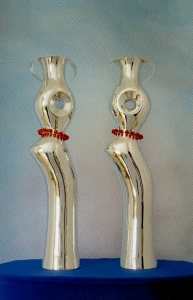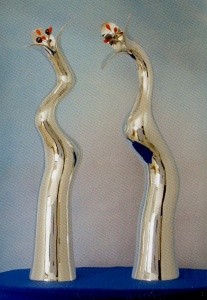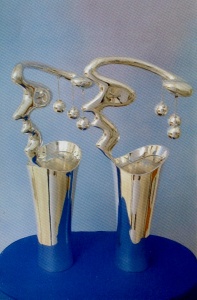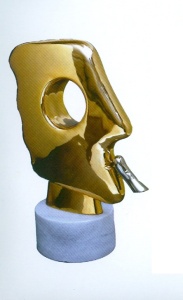Zabari’s Figures
Moshe Zabari has accomplished a remarkable feat… he has put the Matriarchs literally on top of the Torah. What a triumph for religious feminism, what a triumph for Jewish Art! His recent series of sterling silver Torah Finials (Rimonim) feature Sarah, Rebecca, Rachel and Leah as the honored subjects to effectively crown our holy scrolls.

The set of four represents each matriarch in his signature modern form that in no way violates the modesty demanded of the Torah nor the modesty exemplified by Sarah, Rebecca, Rachel and Leah. In these works currently on view at the Hebrew Union College-Jewish Institute of Religion Museum the artist demands that cutting edge design must become a substantive narrative, therefore each piece is accompanied by a specific text to allow us to accurately understand the sculpture.
“Sarah laughed to herself, saying, ‘Now that I am withered, am I to have enjoyment with my husband so old’” abstractly evokes two upright figures, each head lightly crowned with carnelian and silver beads. The heads are tossed back in mirth and apprehension.
The Rimonim celebrating Rebecca gracefully curves up and is crowned by an elegant water jug paradoxically pierced by a hole. Just below the jug a ring of rose-colored carnelian beads imply a waistband or necklace. “She quickly lowered her jar and said, ’Drink, and I will also water your camels.’” Zabari’s sculpture expresses how the child bride for Isaac exemplifies a rare combination of dutiful kindness and earthly sensitivity.

That “…Rachel was shapely and beautiful” we all know, but Zabari evokes this in slow but emphatic curves that are crowned with a three leafed blossom flowering with coral and enamel beads. Thereby the graceful beauty of Rachel is effectively captured by a calligraphic abstraction in silver.

Leah’s Rimonim are more complex just as she was; “Leah had weak eyes.” “…Reuben came upon some mandrakes in the field and brought them to his mother Leah.” A stark profile of a female face sits atop the two silver pitchers that cover the Torah staves. Her eyes and mouth express a tragic anguish while the simple shape of her hair supports three hanging silver balls that evoke the little silver or gold bells found on many more traditional Rimonim. These Torah sculptures are properly seen as a series, each reinforcing and contrasting the other. The almost figurative depiction of Leah’s profile and Rebecca’s water jug lend substance to the much more abstract forms found in the Sarah and Rachel Rimonim. Likewise the visual poetry in Sarah and Rachel give license for the liberties taken with the figurative elements.
Moshe Zabari comes to these artworks well prepared. A graduate of the Bezalel School of Arts in Jerusalem in 1958, he soon afterward came to the Jewish Museum in New York as artist-in-residence at the Tobe Pascher Workshop for the creation of Judaica in a contemporary style. He was the director of the Workshop from 1981 until his return to Israel in 1988. For twenty years he worked with the master silversmith Ludwig Yehuda Wolpert (1900-1981), considered by many to be the first artist to integrate Hebrew lettering in the design of ritual objects and a proponent of Bauhaus inspired form and design. Zabari has completed countless commissions of every type of silver Judaica imaginable in addition to many synagogue sculptures and installations of Ark doors, facades, menorahs, etc. His work is featured in The Jewish Museum, Museum of Modern Art, Smithsonian Institute, HUC Skirball Cultural Center and Museum, Los Angeles, B’nai B’rith Klutznik Museum, Washington, D.C., Spertus Museum of Judaica, Chicago and Israel Museum, Jerusalem in addition to many synagogues and public spaces throughout the world.
Interestingly enough in spite of his prolific career this exhibition presents a unique aspect of his recent creativity in the introduction of the human form as a means of narration of Jewish themes.
A free standing Job (2002) is an homage to S. Y. Agnon and his book Shira Agnon set in Jerusalem in the 1930s and 1940s. This gold plated brass sculpture presents a fractured view of the archetypical man of suffering; made of flat shapes seemingly bolted together as Job simultaneously reaches heavenward and, with his other outstretched arm, contemplates his worldly existence. The ground tilts forward to further unsettle his fragile equilibrium.

Equally insightful is Revelation: Jeremiah (1997), an extreme modernist head in gold-plated brass seen in a bold three dimensional profile. Perched on his closed lips is a single silver finger reflecting the verse; “Then Hashem extended His hand and touched my mouth… Behold, I have placed My words in your mouth” (Jeremiah 1:9). Jeremiah’s eye, represented by an enormous hole, aptly symbolizes the prophet’s newfound power of insight.
Among the other works shown is a delightful Purim Mask (1992) that features a silver crown of Ahasuerus, hamentashen shaped eye, the ruby red lips of Queen Esther and flaring nostrils of Mordechai’s horse. The wit, creativity and pure skill of fashioning this object breathes life into these frequently overused symbols. Unfortunately in a series of other works shown here, the simplistic use of symbolism has a deadening effect on otherwise well intentioned visions. His ambitious series of the Five Books of the Torah in Portuguese marble, Alabaster, granite and black Spanish marble are not up to the far reaching figurative pieces.
Moshe Zabari is searching out a radical terrain by turning to uniquely figurative elements in expanding the very possibilities of what silver sculpture and Judaica can accomplish. In a way his is doing what he has always done best, evoking Jewish meaning from modernist form. But now with the use of the human form the meanings he finds inherently begin to narrate just as they do in our texts and our experience. This departure, especially for such a well established artist, is equally courageous and fruitful and shows what can be accomplished by an artist who returns again and again to the endless well of Jewish text and experience continually thirsty and curious.